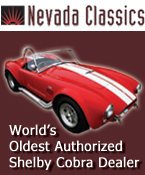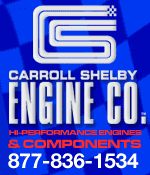
01-13-2007, 01:34 PM
|
|
CC Member

|
|
|
Join Date: May 2006
Location: St. Louisville,
Oh
Cobra Make, Engine: A&C 67 427 cobra SB
Posts: 2,445
|
|

 Not Ranked
Not Ranked
 Dyno numbers misleading?
Dyno numbers misleading?
Every dyno run I have seen on TV were, what I will call, a dynamic, as apposed to static, test. What I mean by dynamic is that the motor rpm are increasing, as the measure of torque is made. In a static test, the motor rpm would be constant, as you measured the torque, in which case the torque output of the motor would be in perfect balance with the resistance of the dyno. It is easy to see that doing a static test at every few hundred rpm would be a real PITA. Hence the use of the dynamic test.
However this brings me to my point. An engine has a lot of rotating mass. The bigger the engine the more the mass. It takes energy to accelerate this rotating mass, and if I remember my physics correctly this is called inertia. Let's say, for purposes of discussion, that a particular engine at WOT takes 0.6 seconds to free rev from 2000 to 6000 rpm and that the engine outputs a true time weighted average of 400 lb-ft of torque through this rpm range. This then means that it takes 400 lb-ft of torque to accelerate the rotating mass of this engine from 2000 to 6000 rpm in 0.6 seconds. If we cut the output to 1/10 or 40 lb-ft, it would stand to reason that it would then take 10 times as long or 6 seconds to accelerate from 2000 to 6000 rpm. Now if we put this engine on a dyno, and during the dynamic test the engine goes from 2000 to 6000 rpm in 6 seconds, what would the dyno measure? I suggest that it will measure the torque output of the engine as a time weighted average of 360 lb-ft, as 40 lb-ft will be going to accelerating the mass of the engine and 360 lb-ft will be going to turning the dyno, which adds up to the 400 lb-ft of the true torque the engine can output in a static condition.
To go one step further, if the dynamic dyno test took 12 seconds to go through the same 4000 rpm range on the same engine, then only 1/20 of the true torque would be going to accelerate the rotating mass. So in this test, 20 lb-ft would be lost to inertia and the dyno would measure 380 lb-ft. Like wise if the inertia was cut in half and the engine only required 0.3 seconds to free rev through the same 4000 rpm range and again the dynamic dyno test took 6 seconds, we would have the same 1/20 of the true torque lost to inertia and would measure 380 lb-ft.
I believe this explains why a chassis dyno measures less torque/hp at the wheels if you measure in 3rd gear than in 4th gear. The lower the gear the quicker the engine revs up and the more energy is consumed by inertia.
What do you think?

|



















 Threaded Mode
Threaded Mode

